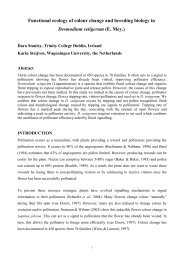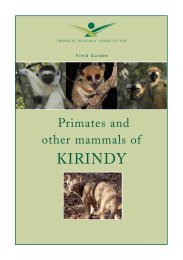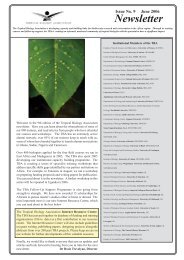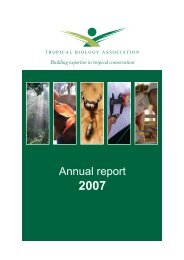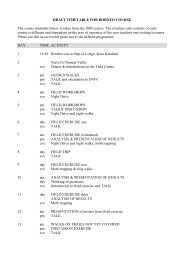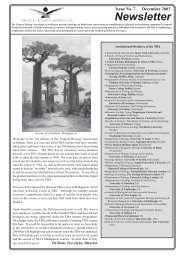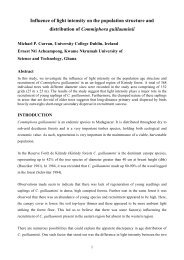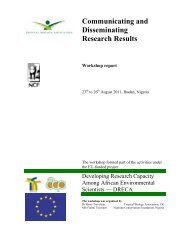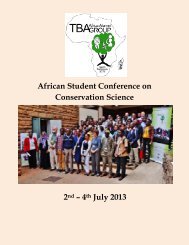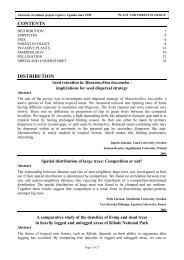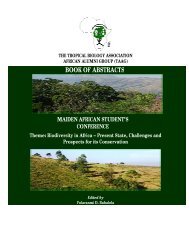Plant and forest ecology - Tropical Biology Association
Plant and forest ecology - Tropical Biology Association
Plant and forest ecology - Tropical Biology Association
Create successful ePaper yourself
Turn your PDF publications into a flip-book with our unique Google optimized e-Paper software.
Abstracts of student project reports: Madagascar courses since 2002<br />
PLANT AND FOREST ECOLOGY<br />
CONTENTS<br />
Distribution 1<br />
<strong>Plant</strong> <strong>ecology</strong> 4<br />
Pollination 9<br />
DISTRIBUTION<br />
Abstract<br />
Distribution <strong>and</strong> regeneration of Adansonia rubrostipa in Kirindy Forest<br />
A population of Adansonia rubrostipa was assessed for spatial distribution <strong>and</strong> regeneration within<br />
an area of 168,125 m 2 . It was found that the individuals in the area are significantly aggregated <strong>and</strong><br />
that there are few small individuals. Seeds were proven to be viable <strong>and</strong> germination success<br />
depended on the treatment received. These findings are informative concerning the conservation<br />
status of A. rubrostipa. We conclude that the population is still regenerating, however it is doing so<br />
at a low rate.<br />
Jennifer Helps, Oxford University, Engl<strong>and</strong><br />
Lisa Kernegger, University of Vienna, Austria<br />
The effects of logging roads on tree composition, structure <strong>and</strong> species diversity<br />
Abstract<br />
The effects of logging, including consequent edge effects, are well understood in tropical rain<strong>forest</strong>,<br />
but much less so in tropical dry <strong>forest</strong> like Kirindy <strong>forest</strong>, western Madagascar. Kirindy has a<br />
history of selective logging <strong>and</strong> is highly threatened by current illegal logging activity. This study<br />
used four transects, placed perpendicular to a main logging road at least 200 m apart, to consider<br />
whether there were changes in <strong>forest</strong> structure <strong>and</strong> composition with distance from the road<br />
(perhaps attributable to edge effects) <strong>and</strong> also whether there were differences between transects. On<br />
each transect, six 5 x 5 m quadrats were created at 0, 5, 10, 15, 20 <strong>and</strong> 100 m from the road. Within<br />
these, each woody individual was identified (if not with the species name, with a species number)<br />
<strong>and</strong> the circumference measured if it was more than 4 cm in diameter.<br />
No evidence emerged for edge effects of the road on <strong>forest</strong> structure or diversity, probably because<br />
Kirindy, being naturally dry <strong>and</strong> open, is less vulnerable to such effects. However, some species<br />
showed patterns of changing frequency away from the road, suggesting some effect on composition;<br />
further investigation is required. It was found that large trees did decrease in frequency nearer the<br />
road, but this is probably a direct effect of selective removal rather than an edge effect. Large trees<br />
also decreased in frequency further from the camp, between the transects, possibly because of<br />
increasing intensity of illegal logging. Species diversity <strong>and</strong> composition also varied between<br />
transects, indicating spatial heterogeneity on a scale of hundreds of metres.<br />
2002<br />
David Lekeaka, University of Dschang, Cameroon<br />
Eloise Phipps, University of Cambridge, UK<br />
2003<br />
Page 1 of 11
Abstracts of student project reports: Madagascar courses since 2002<br />
PLANT AND FOREST ECOLOGY<br />
Abstract<br />
Spatial dispersion of plants <strong>and</strong> animals along a transect in tropical dry<br />
deciduous <strong>forest</strong><br />
The aim of our study was to investigate if pollinators <strong>and</strong> seed dispersers affect the spatial<br />
distribution of two plant species in a dry deciduous <strong>forest</strong> in western Madagascar. We used the T-<br />
square method (Ludwig <strong>and</strong> Reynolds 1988 in Behler <strong>and</strong> Böhning-Gaese 2001) along a transect to<br />
investigate if distribution differed from r<strong>and</strong>om. The method was also used to assess the spatial<br />
dispersion of animals. The results showed no effect of pollinator on plant distribution as both<br />
species showed a r<strong>and</strong>om pattern, whereas animal distribution was clumped. We consider this<br />
method to be a proper tool for both plant <strong>and</strong> animal distribution analysis.<br />
Abstract<br />
John Kvarnbäck, Lund University, Sweden<br />
Theresa Heitzlhofer, University of Vienna, Austria<br />
Abundance <strong>and</strong> establishment success of Strychnos mostueoides<br />
in Kirindy Forest<br />
Kirindy Forest is a dry deciduous <strong>forest</strong> in the Menabe region, western Madagascar. It has been<br />
used for logging between 1978 <strong>and</strong> 1984. We studied the effects of the logging by measuring the<br />
establishment success of one plant species, Strychnos mostueoides. To do so, we compared logged<br />
<strong>and</strong> l<strong>and</strong>ing areas, <strong>and</strong> logged <strong>and</strong> unlogged areas with regards to: 1) absolute abundance <strong>and</strong> 2)<br />
relative abundance of S. mostueoides size classes. Logged areas had more individuals than both<br />
l<strong>and</strong>ing <strong>and</strong> unlogged areas. Of the four size classes, the saplings were the most widespread in all<br />
three habitats. However, the difference between the saplings <strong>and</strong> the three other size classes was the<br />
most striking in the logged areas. S. mostueoides appeared to be least established in the l<strong>and</strong>ing<br />
places, where the level of disturbance due to logging activities was the highest.<br />
Abstract<br />
2004<br />
Dragana Trivic, Lund University, Sweden<br />
Godwin Ndemeere, Makerere University, Ug<strong>and</strong>a<br />
Julie Marsaud, Université Pierre et Marie Curie, France<br />
Distribution of Commiphora guillaumini in Kirindy Forest<br />
The 25 ha area of CS5 in Kirindy Forest, divided into 400 plots of roughly 25 x 25 m 2 was<br />
investigated, the DBH <strong>and</strong> spatial location of the population of Commiphora guillaumini were<br />
collected. A total of 195 individuals including 18 planted C. guillaumini were recorded. 38% of the<br />
non-planted trees were bearing fruits. The result of the data grouped into 100 sampling units of<br />
roughly 50 x 50 m 2 <strong>and</strong> analysed using Excel <strong>and</strong> Statview shows that Commiphora guillaumini is<br />
r<strong>and</strong>omly dispersed in CS5. This result also indicates the lack of natural regeneration of this species<br />
which cannot be precisely linked to the logging activities which took place in 1980s in this area.<br />
2007<br />
Achille Baudelaire Momo, University of Yaounde I, Cameroon<br />
Evelyn Asante-Yeboah, Kwame Nkrumah University of Science <strong>and</strong> Technology, Ghana<br />
2008<br />
Page 2 of 11
Abstracts of student project reports: Madagascar courses since 2002<br />
PLANT AND FOREST ECOLOGY<br />
Abstract<br />
Forest structure on a soil gradient in Kirindy Forest<br />
(Menabe region, Madagascar)<br />
Though the dry deciduous <strong>forest</strong> of Kirindy has been studied, little of this research has drawn<br />
attention to how significant the role of evergreens is within the <strong>forest</strong> structure. Field observation<br />
suggested not only that evergreen plants are an important component of the vegetation but also that<br />
the <strong>forest</strong> structure changed across different soil types. With this project, we found a significant<br />
relationship between the soil type <strong>and</strong> the frequency of deciduous <strong>and</strong> evergreen plants <strong>and</strong> average<br />
height of canopy. We are however unable to identify this relationship as dependency or correlation<br />
with unstudied factors.<br />
Abstract<br />
George Percival, National University of Irel<strong>and</strong> Galway, Irel<strong>and</strong><br />
Nuno Veríssimo Pereira, Georg-August-Universität Göttingen (Germany), Portugal<br />
Tendai Musvuugwa, University of Cape Town (South Africa), Zimbabwe<br />
Forest structural variables <strong>and</strong> evergreen tree composition<br />
along the Kirindy river<br />
The structural variables (height, dbh ≥10 cm, density) <strong>and</strong> evergreen species composition of trees of<br />
the riparian <strong>forest</strong> were investigated across the Kirindy river. 20 transects were set up<br />
perpendicularly to the river to sample the vegetation.There was variation in the dbh, tree density<br />
<strong>and</strong> species composition only within twenty metres. This is probably because the river has an<br />
influence only within twenty metres over the vegetation of the riparian <strong>forest</strong>. Probably more<br />
transects <strong>and</strong> other components such as soil types <strong>and</strong> degree of humidity have to be studied during<br />
the rainy season to clearly establish the influence of the river on the vegetation.<br />
2009<br />
Djomo Nana Eric, University of Yaounde, Cameroon<br />
Chabi A.M.S. Djagoun, University of Abomey-Calavi, Benin<br />
Noelikanto Ramamonjisoa, University of Antananarivo, Madagascar<br />
Regeneration in logging trails in comparison to the adjacent lightly logged <strong>forest</strong><br />
in Kirindy: the case of Strychnos decussata as a focus species<br />
Abstract<br />
The operation of silviculture, despite selective timber felling, has impacts on a <strong>forest</strong> <strong>and</strong> its ability<br />
to recover. The ability to recover can be assessed for example by the faculty of the regeneration of<br />
the <strong>forest</strong>. Using a paired transect sampling methodology we investigated the differences of tree<br />
regeneration between logging trails <strong>and</strong> adjacent lightly logged <strong>forest</strong>. Our focus on Strychnos<br />
decussata enabled us to further analyse a specific tree species to assess the regeneration <strong>and</strong> its<br />
ability to colonise the gaps created by logging trails. Results indicated there was a statistically<br />
significant difference between the logging trails <strong>and</strong> lightly logged <strong>forest</strong> in terms of environment,<br />
excluding stem count. There was no significant difference between the stem counts of the logging<br />
trails <strong>and</strong> lightly logged <strong>forest</strong>. Ring count analyses of harvested Strychnos decussata found that<br />
saplings under the height of 0.5 m were aged less than 10 years old indicating new regeneration.<br />
This age analysis equation was applied to the Strychnos decussata found within the paired transects.<br />
Regeneration is more favourable in lightly logged <strong>forest</strong> than logging trails indicating the impact of<br />
past <strong>forest</strong>ry operations on regeneration rates.<br />
2009<br />
Page 3 of 11
Abstracts of student project reports: Madagascar courses since 2002<br />
PLANT AND FOREST ECOLOGY<br />
Percy Yvon Rakoto, University of Antananarivo, Madagascar<br />
Samantha Alison Hook, University of Salford, UK<br />
2013<br />
PLANT ECOLOGY<br />
Assessment of dispersal <strong>and</strong> predation of Strychnos decussata fruits <strong>and</strong> seeds<br />
by frugivorous tree visitors in Kirindy Forest<br />
Abstract<br />
The study was conducted in the dry <strong>forest</strong> of Kirindy, Madagascar to observe frugivorous tree<br />
visitors, quantify seed predation <strong>and</strong> fruit dispersal rates for Strychnos decussata (Loganaceae).<br />
Ten individual trees were investigated for five days using quadrats (1 m x 1 m). Four located near<br />
(1 m) <strong>and</strong> four far (5 m) on each tree. A total of 80 quadrats were established for the 10 trees. The<br />
Lemur, Eulemur fulvus rufus was the only frugivorous visitor observed during the period. From<br />
daily collections of fruit from beneath the canopy, a significant difference was observed on the fruit<br />
condition with over 70% of fruits damaged by mammals compared to intact fruits <strong>and</strong> those<br />
damaged by insects. Also, a significant effect of distance was observed as most damaged fruits<br />
dropped within 1 m from the tree than five metres away. For seed predation <strong>and</strong> fruit dispersal,<br />
more seeds (76%) <strong>and</strong> fruits (66.6%) were removed further (10 m) than near (1 m), 24% for seeds<br />
<strong>and</strong> 33.3% for fruits showing a strong significance.<br />
Abstract<br />
Ambe Julius , University of Buea, Cameroon<br />
Geoffrey Soka, Sokoine University of Agric., Tanzania<br />
Susan Imbahale, University of Nairobi, Kenya<br />
The fate of the seeds of Cordyla madagascariensis<br />
The predation <strong>and</strong> dispersal of Cordyla madagascariensis has been studied. The predation rate<br />
under the canopy <strong>and</strong> on the tree of 12 individuals was investigated. Furthermore, a predation<br />
experiment was carried out with natural seeds <strong>and</strong> fruits, as well as with seeds treated in two ways<br />
a) boiled <strong>and</strong> b) boiled <strong>and</strong> testae removed. Additionally, the distribution of the Cordyla<br />
madagascariensis individuals was investigated, both around the study trees <strong>and</strong> in another area was<br />
investigated. The predation rate was higher on the <strong>forest</strong> floor than on the tree. Seeds or fruits were<br />
not dispersed by this type of predation. Seed dispersal seems to be important because of<br />
intraspecific competition: the girth of trees increased with increasing distance from an adult tree.<br />
The tree distribution was r<strong>and</strong>om, which indicates seed dispersal. The disperser could be Eulemur<br />
fulvus rufus, which predates the fruits on the tree.<br />
2002<br />
Rindra Ramanankirahina,University of Antananarivo, Madagascar<br />
Maaike de Vlas, University of Groningen, The Netherl<strong>and</strong>s<br />
Beatrice Vonlanthen, University of Fribourg, Switzerl<strong>and</strong><br />
2002<br />
Page 4 of 11
Abstracts of student project reports: Madagascar courses since 2002<br />
PLANT AND FOREST ECOLOGY<br />
Is a green bark character an adaptation to dry conditions in Kirindy Forest<br />
Abstract<br />
Green bark trees are common in Kirindy dry <strong>forest</strong>. The green back trait is common among<br />
different families <strong>and</strong> most have no leaves during the dry season. This suggests that green bark in<br />
trees is likely to be an adaptation to the dryness. Observations under the microscope revealed that<br />
strata of green cells are just beneath the strata of dead cells. This may suggest the photosynthetic<br />
role of the bark in absence of leaves in most trees. Thus from our study we could be able to suggest<br />
that green bark assumes the role of leaves in dry season.<br />
Abstract<br />
Assogba Gbed<strong>and</strong>e, National University of Benin, Benin<br />
Aloysius Shija, Sokoine University of Agriculture, Tanzania<br />
Fate of baobab (Adansonia rubrostipa) fruits<br />
in dry deciduous <strong>forest</strong> of Kirindy<br />
A population of Adansonia rubrostipa was assessed for reproductive potential, faunal fruit predation<br />
<strong>and</strong> invertebrate species composition <strong>and</strong> interactions within fruits. Most of the trees in the study area<br />
were found fruiting, producing on average 30.0 fruits. However, due to faunal predation, few of the<br />
seeds will have a chance to germinate. Only 21% of examined fruits did not have external openings;<br />
vertebrates accounted for destroying 34% of fruits, <strong>and</strong> insects – for opening 42%. As traces of insect<br />
feeding were also detected in many vertebrate-opened, crack-opened or even unopened fruits, insects<br />
were the most important baobab fruit predators. A. rubrostipa fruits are important microhabitats for a<br />
number of invertebrate species. 32 species, belonging to 4 classes <strong>and</strong> 11 orders, were detected inside<br />
the fruits, linked with 11 interactions in terms of co-occurrence. Their preferred habitat characteristics<br />
were also recorded. The results enabled us to suggest a general pattern of invertebrate fruit invasion,<br />
leading to complete destruction of pulp <strong>and</strong> seeds.<br />
2003<br />
Piotr Łukasik, Jagiellonian University, Pol<strong>and</strong><br />
Todd Johnson, Livingstone Museum, Zambia<br />
Vertebrate dispersal <strong>and</strong> predation processes of seeds <strong>and</strong> seedlings in a species<br />
of Strychnos in a dry deciduous <strong>forest</strong> in western Madagascar<br />
Abstract<br />
We investigated the effects of distance from a species of Strychnos on seed predation <strong>and</strong> fruit<br />
dispersal by vertebrate fruit eaters. Seed <strong>and</strong> fruit number <strong>and</strong> condition were analysed in quadrats<br />
placed near <strong>and</strong> far to 25 parent tree canopies. Fruit trapping was used to investigate seed dispersal<br />
by arboreal vertebrates dropping fruit whilst feeding, <strong>and</strong> groups of seeds near <strong>and</strong> far from 30<br />
parent canopies were monitored to examine predation rates by terrestrial vertebrates. We postulate<br />
that diurnal vertebrates, particularly Eulemur fulvus, are especially important in seed dispersal <strong>and</strong><br />
that both diurnal <strong>and</strong> nocturnal vertebrates, although especially the latter, act as seed predators.<br />
2004<br />
Isabelle Olivia Baumgartner, University of Zurich, Switzerl<strong>and</strong><br />
Kate Elizabeth McNutt, University of East Anglia, Engl<strong>and</strong><br />
2004<br />
Page 5 of 11
Abstracts of student project reports: Madagascar courses since 2002<br />
PLANT AND FOREST ECOLOGY<br />
Abstract<br />
Seed predation of Adansonia za <strong>and</strong> A. rubrostipa in Kirindy Forest<br />
A population of Adansonia za <strong>and</strong> A. rubrostipa were assessed for differences in seed predation <strong>and</strong><br />
invertebrate species composition. Twelve groups of invertebrate were found in the fruits of A.<br />
rubrostipa <strong>and</strong> only one in A. za. Weevils were the primary invaders with percentage frequency of<br />
14.34%. Black beetle were detected as secondary invaders causing complete destruction of the pulp <strong>and</strong><br />
seeds. Bright red <strong>and</strong> black hemipterans also invade the fallen fruits of both species; these are members<br />
of the family Pyrrhocoridae, which seem to eat the dry pulp around the seed destroying the pulp <strong>and</strong><br />
seeds. Viability of the damaged seed was also determined but none of the seeds planted germinated.<br />
Abstract<br />
Halima Abdillahi, National Museums of Kenya, Kenya<br />
Tahiry Andrianilana Raveloarison, University of Antananarivo, Madagascar<br />
Do the soil characteristics influence the vegetation type<br />
A study of a dry deciduous <strong>forest</strong> in Madagascar<br />
The vegetation formation in Madagascar is influenced by different factors. The soil is part of those<br />
main factors. Our study was carried out in the <strong>forest</strong> of Kirindy, a dry deciduous <strong>forest</strong> growing on a<br />
s<strong>and</strong>stone soil. Kirindy is located in the western coast of Madagascar. It is characterised by three<br />
types of <strong>forest</strong>: dry <strong>forest</strong>, deciduous <strong>forest</strong> <strong>and</strong> evergreen <strong>forest</strong>. The aim of the work is to study the<br />
effect of the soil in the different vegetation in Kirindy. We sample the vegetation <strong>and</strong> the soil to<br />
analyze the interaction between the soil <strong>and</strong> vegetation. We found that the characteristics of the three<br />
types of the <strong>forest</strong> are different but the soil characteristics are not determinatives to explain this<br />
difference.<br />
Abstract<br />
2006<br />
Lovanomenjanahary Marline, University of Antananarivo, Madagascar<br />
Walter Paulin Tapondjou Nkonmeneck, University of Yaoundé I, Cameroon<br />
Seed dispersal by wind in Kirindy Forest: relationships between<br />
wing loading, seed shadows <strong>and</strong> tree heights<br />
The objective of this study was to investigate how the traits of wind dispersed propagules relate to<br />
dispersal distance within a species (intraspecific) <strong>and</strong> between different species (interspecific).<br />
Between species, we hypothesised that tree species face a trade-off between canopy height <strong>and</strong> wing<br />
loading, mass per surface area of the seed. We measured seed shadows <strong>and</strong> seed traits of six wind<br />
dispersed tree species. We found that time of descent (TOD) was negatively related to wing loading,<br />
intra <strong>and</strong> interspecific. Within a seed shadow, there were no differences in wing loading <strong>and</strong> TOD.<br />
However, wing loading seems to affect the shape of the seed shadow of a tree species. We didn’t find<br />
evidence for an interspecific trade-off between wing loading <strong>and</strong> tree height, although there is a<br />
tendency.<br />
2010<br />
Froukje Postma, Groningen University, the Netherl<strong>and</strong>s<br />
Rence R<strong>and</strong>rianindrina, University of Antananarivo, Madagascar<br />
Sendi Baptista, Catholic University of Angola, Angola<br />
2010<br />
Page 6 of 11
Abstracts of student project reports: Madagascar courses since 2002<br />
PLANT AND FOREST ECOLOGY<br />
Abstract<br />
Fate of the baobab seed, Adansonia rubrostipa<br />
This study aimed to investigate whether or not the Malagasy giant jumping rat, Hypogeomys<br />
antimena, was involved in the dispersal of one of the endemic Madagascan baobab species,<br />
Adansonia rubrostipa after what was considered its primary disperser - the Archaeolemur - went<br />
extinct with the arrival of humans. Whilst there were no clear results in this respect, observations over<br />
nine days in Kirindy Forest revealed an interaction between H. antimena, Macrotarsomys bastardi<br />
<strong>and</strong> the experimental A. rubrostipa seeds. Novel interactions with Aphaenogaster swammerdami were<br />
also observed, indicating that this ant may be able to carry greater weights than recorded for the<br />
majority of ant species.<br />
Jayaneesh Namah, University of Mauritius, Mauritius<br />
Alex<strong>and</strong>ra Cole, Swansea University, UK<br />
The adaptations of plants in fire-prone ecosystems: savanna <strong>and</strong> dry deciduous<br />
<strong>forest</strong> of Kirindy, Western Madagascar<br />
Abstract<br />
In fire-prone ecosystems we can find particular adaptations of the plants to resist several environmental<br />
stresses <strong>and</strong> first of all the fire. In this study, we documented post-burn re-sprouting response of the<br />
woody plants in a savanna vs. a dry deciduous <strong>forest</strong>. We measured bark thickness in relation to plant<br />
size in <strong>forest</strong>s <strong>and</strong> savanna trees as a key fire survival trait. We found that most of the savanna trees have<br />
relatively thick bark, especially in the juvenile stages, re-sprout vigorously <strong>and</strong> grow tall rapidly postburn.<br />
Forest trees were thin-barked, with high mortality <strong>and</strong> slow regrowth of the few small surviving<br />
plants after a <strong>forest</strong> fire. To underst<strong>and</strong> the origin of savanna we compared the proportion of endemic<br />
plants in both habitats, characterised the soils <strong>and</strong> used other additional bio-indicators. The savanna is of<br />
edaphic origin <strong>and</strong> contains both endemic <strong>and</strong> non-endemic fire-tolerant woody species.<br />
2011<br />
Fetrarimalala R<strong>and</strong>riatsara, University of Anatananarivo, Madagascar<br />
Cristian Trani, University of Trieste, Italy<br />
How does a rare understorey species survive in a dry deciduous <strong>forest</strong> – A case<br />
study on Uncarina le<strong>and</strong>rii in Kirindy Forest, Madagascar<br />
Abstract<br />
In investigating the survival strategies of a little researched rare species of shrub, Uncarina le<strong>and</strong>rii, in a<br />
highly seasonal habitat it was necessary to focus on a number of factors, including: the demographic<br />
distribution <strong>and</strong> dispersion, morphological aspects, phenology, pollination syndrome <strong>and</strong> reward for<br />
pollinators. This study showed that U. le<strong>and</strong>rii is self-incompatible, relying on visitation by bee<br />
pollinators for development of fruits. While the number of inflorescences correlates with plant height<br />
<strong>and</strong> diameter at breast height (DBH), fruit production does not. Nor does it correlate with near<br />
neighbour distances. The demographic survey indicates a normally distributed population within<br />
Kirindy. The spatial distribution shows that while some individuals are found in clumped patches, others<br />
have been dispersed widely in isolation. The above findings suggest that the strategies of this rare plant<br />
are working.<br />
2011<br />
Emmanuel Olabode, University of Ibadan, Nigeria<br />
Sarah O’Loughlin Irwin, National University of Irel<strong>and</strong>, Galway, Irel<strong>and</strong><br />
2011<br />
Page 7 of 11
Abstracts of student project reports: Madagascar courses since 2002<br />
PLANT AND FOREST ECOLOGY<br />
Abstract<br />
Hungry caterpillars – herbivory in a dry, deciduous tropical <strong>forest</strong><br />
(Kirindy Forest, Madagascar)<br />
Herbivory on plants by phytophagous insects in dry, deciduous <strong>forest</strong>s is relatively understudied<br />
compared to tropical rain <strong>forest</strong>s. Here, we present a preliminary investigation into different aspects<br />
of herbivory on a locally abundant understorey shrub (Erblichia sp., Turneraceae) at two sites in the<br />
seasonally-arid Kirindy Forest of western Madagascar. Both the distance from a path (‘edge effect’)<br />
<strong>and</strong> leaf biomass appeared to affect the level of herbivory on individual plants; by being further<br />
away from a path <strong>and</strong> being larger increased escape from herbivory. We found that there was no<br />
effect of the level of herbivory on the ability of the plant to produce flowers. Our single point in<br />
time for data collection may obscure any effect, <strong>and</strong> further investigation should look at the change<br />
of herbivory <strong>and</strong> flower production over the course of wet season start. Erblichia appears to be a<br />
species adapted to the dry, deciduous <strong>forest</strong> because the plants respond rapidly to the onset of rain,<br />
flush leaves synchronously, <strong>and</strong> the flowers are short lived.<br />
Abstract<br />
Page 8 of 11<br />
Aidan Vey, University of Portsmouth, United Kingdom<br />
Vera Hoffmann, University of Cape Town, South Africa<br />
Janzen-Connell effects, seed predation <strong>and</strong> fruit dispersal in the baobab<br />
Adansonia rubrostipa<br />
Dispersal of seeds <strong>and</strong> seedling establishment are important drivers of tropical <strong>forest</strong> dynamics <strong>and</strong><br />
strongly related to the progenies’ distance from the maternal tree. Our study aims to assess whether<br />
patterns of seed predation <strong>and</strong> potential dispersal gradients in A. rubrostipa are in accordance with<br />
the Janzen-Connell model describing this pattern. The amount of fruit declined with distance from<br />
the maternal trunk <strong>and</strong> dispersal distance from the tree did not exceed canopy width. Fruit condition<br />
roughly showed an equal distribution along the distance gradient. Seed predation by curculionid<br />
beetles occurred in more than half of the assessed fruits, indicating that these weevils are the main<br />
seed predators. Predation did not differ significantly over distance. Seedling recruitment in A.<br />
rubrostipa might be severely constrained by the absence of an effective disperser. Production of<br />
larger fruits seems to be a way to ensure a higher number of viable seeds, which allows more intact<br />
seeds to survive seed predation due to predator saturation.<br />
2012<br />
Jesse Erens, University of Wageningen, Netherl<strong>and</strong>s<br />
Anita Freudmann, University of Vienna, Austria<br />
Ewa Komar, University of Warsaw, Pol<strong>and</strong><br />
The relationship between the length of liana <strong>and</strong> the size of succulent stem of<br />
Adenia firingalavensis<br />
Abstract<br />
This study was conducted on Adenia firingalavensis in the dry deciduous <strong>forest</strong> of Kirindy,<br />
Madagascar during the end of the dry season. A clear relationship (allometric scaling) was found<br />
between the parameters of the succulent stem (volume, surface area, <strong>and</strong> diameter) <strong>and</strong> the length of<br />
the liana; increasing size of these characters scale with increased length of the liana. The succulent<br />
stem is assumed to have roles in photosynthesis <strong>and</strong> water retention as adaptations to the extended<br />
dry season.<br />
2012<br />
Asimenye Nthakomwa, University of Malawi, Bunda College, Malawi
Abstracts of student project reports: Madagascar courses since 2002<br />
PLANT AND FOREST ECOLOGY<br />
Solonombana Koly Vitantsoa, University of Antananarivo, Madagascar<br />
Variation in nectar volume <strong>and</strong> sugar concentration in the nectar of<br />
Chadsia flammea in Kirindy Forest<br />
Abstract<br />
<strong>Plant</strong>s limit the production of nectar to the needs of the pollinators. Chadsia flammea in particular<br />
which is pollinated by sunbirds is no exception. The study investigated the variation in volume of<br />
nectar produced by Chadsia <strong>and</strong> the sugar concentration of the nectar during the day. It also<br />
investigated the variation between young flowers <strong>and</strong> older flowers. There was a significant<br />
difference between sugar concentration <strong>and</strong> time of the day <strong>and</strong> the age of the flower.<br />
2012<br />
Lauren Kelly, University of Salford, UK<br />
Sarah Lehner, University of Graz, Austria<br />
S<strong>and</strong>y Oduor, National Museums of Kenya, Kenya<br />
Effects of environmental variables <strong>and</strong> time of the day on the visitation patterns<br />
to the Neem tree (Azadirachta indica) in Kirindy <strong>forest</strong>, Madagascar<br />
Abstract<br />
The visitation frequencies to Neem (Azadirachta indica) in relation to environmental variables <strong>and</strong><br />
time of the day were studied in Kirindy Forest, Madagascar. From the scan <strong>and</strong> focal sampling, the<br />
number of visitors present on a patch of flowers <strong>and</strong> their behaviours were recorded. Significant<br />
differences in the number of visitors throughout the day were observed with a clear bimodal activity<br />
pattern; one peak in the morning <strong>and</strong> another in the evening. Time spent on flowers <strong>and</strong> number of<br />
flowers visited differed between visitors. High fruit production <strong>and</strong> long floral life were also<br />
observed. A. indica is an introduced species in the study area <strong>and</strong> the results obtained suggest a high<br />
potential of becoming invasive in the future. It is recommended that further planting of A. indica<br />
outside its native range should be done with caution.<br />
2012<br />
Manqoba Zungu, University of KwaZulu-Natal, South Africa<br />
Jennifer Konadu, Kwame Nkrumah University of Science <strong>and</strong> Technology, Ghana<br />
2013<br />
POLLINATION<br />
Abstract<br />
Distribution <strong>and</strong> success of pollination of Vanilla madagascariensis<br />
on the edge <strong>and</strong> within the <strong>forest</strong><br />
The main aim of this study was to evaluate the distribution of the Vanilla madagascariensis in the<br />
dry deciduous <strong>forest</strong> of Kirindy (East Madagascar) <strong>and</strong> to compare the pollination success between<br />
plants along the edge of <strong>forest</strong> roads <strong>and</strong> within the <strong>forest</strong>. Pollinations were made by h<strong>and</strong> to<br />
estimate the potential success of a pollinator visiting a flower. Field observations were made to<br />
identify the pollinator(s). The vanilla is uneven distributed along <strong>forest</strong> roads <strong>and</strong> within the <strong>forest</strong>.<br />
Along 10 km of roads <strong>and</strong> 0.17 km 2 of <strong>forest</strong> sampled a total of 137 plants were found. They were<br />
mostly clustered, but no pattern or gradient was found. Variables like size, max. height, number of<br />
Page 9 of 11
Abstracts of student project reports: Madagascar courses since 2002<br />
PLANT AND FOREST ECOLOGY<br />
inflorescences <strong>and</strong> fruits <strong>and</strong> distance to nearest neighbour of 20 plants on the <strong>forest</strong> edge <strong>and</strong> 23<br />
plants in the <strong>forest</strong> were measured <strong>and</strong> compared. Individuals along <strong>forest</strong> roads (edge) had a<br />
significant higher number of inflorescences <strong>and</strong> fruits. The pollinator was not found but with the<br />
observations of opening time, nectar production <strong>and</strong> floral morphology different potential<br />
pollinators are discussed.<br />
Abstract<br />
Pollination of Uncarina paederia (Pedaliaceae)<br />
Page 10 of 11<br />
Pascal Querner, University of Vienna, Austria<br />
Uncarina paederia produces yellow flowers that open during the day. The yellow colour combined<br />
with the fact that it has nectar guides suggests it might be insect pollinated. This project therefore<br />
asked the question: who is the pollinator of Uncarina The observations were carried out during 8<br />
days. Two species of bee (Apis sp.) were discovered as the efficient pollinators of Uncarina. Also<br />
the need of a pollinator could be proved with experiments. There were some significant differences<br />
between different areas <strong>and</strong> levels. Some flower nectar robbers <strong>and</strong> destroyers were also observed<br />
visiting the flowers.<br />
2002<br />
Nivohenintsoa Rakotonirina, University of Antananarivo, Madagascar<br />
Zsuzsanna Szocs, University of Vienna, Austr ia<br />
The sugar content of nectar <strong>and</strong> the attractiveness of the flower to visitors<br />
Abstract<br />
This study examined the interaction between plant nectar production <strong>and</strong> flower visitors. We<br />
focused on the relationship between the amount of sugar <strong>and</strong> visitor body size. This involved<br />
measuring sugar concentration of nectar <strong>and</strong> analysis of flower morphology. A strong correlation<br />
was found between visitor body size <strong>and</strong> amount of sugar across the plant species examined. Larger<br />
visitors have greater energy requirements <strong>and</strong> will therefore visit plant species that contain nectar<br />
with greater quantities of sugar.<br />
Abstract<br />
2003<br />
Ana Rita Simones, University of Aveiro, Portugal<br />
Elizabeth Koppenaal, Rijksuniversiteit Groningen, the Netherl<strong>and</strong>s<br />
Graham Wall, University College Dublin, Irel<strong>and</strong><br />
A preliminary early-season flower-visitation web for the Kirindy Forest,<br />
Madagascar<br />
<strong>Tropical</strong> dry <strong>forest</strong> is an endangered ecosystem for which plant-pollinator relationships are<br />
incompletely known. We characterised a portion of the web of interactions between flowering<br />
plants <strong>and</strong> flower visitors in the Kirindy Forest. Taking a plant-centred approach, we observed<br />
individuals of five native plant species that were coming into flower at the end of the annual dry<br />
season, <strong>and</strong> recorded all identifiable flower-visitors. Taking a visitor-centred approach, we walked a<br />
network of established <strong>forest</strong> trails <strong>and</strong> listened for telltale song of the sunbird Nectarinia<br />
souimanga, noting the flowers visited by this common early-season visitor. The former approach<br />
revealed connections among the five early-flowering species via birds <strong>and</strong> various insects, whereas<br />
the latter confirmed these connections <strong>and</strong> added an additional plant species. Flowers of the six<br />
plant species were visited on average by 5.5 animal species, while 10 visitor species for which we<br />
2006
Abstracts of student project reports: Madagascar courses since 2002<br />
PLANT AND FOREST ECOLOGY<br />
had reasonable samples frequented on average the flowers of 3.3 plant species. These qualitative<br />
results agree with those reported from other temperate <strong>and</strong> tropical systems, in that interactions<br />
appeared to be relatively generalised by pollinator species <strong>and</strong> body plan (e.g., birds vs. bees). Also<br />
in agreement, the visitation web was noticeably nested, with more-specialized species tending to<br />
interact with mutualistic partners that were themselves more generalized. In addition to<br />
documenting previously-unreported interactions, therefore, this preliminary web conforms to more<br />
widespread patterns emerging for pollination systems at the community level.<br />
N. Waser et al. (class exercise)<br />
Structural specialisation <strong>and</strong> pollination <strong>ecology</strong> in two Malagasy species of<br />
Dalechampia (Euphorbiaceae)<br />
Abstract<br />
We compared structural features of the blossoms <strong>and</strong> aspects of pollination <strong>ecology</strong> for the<br />
Madagascan endemic vines Dalechampia bernieri <strong>and</strong> D. subternata, characterised by specialised<br />
<strong>and</strong> generalised pollination, respectively. We measured bract aperture <strong>and</strong> length, visitation rate of<br />
the blossoms <strong>and</strong> the amount of pollen on female flowers. As expected, D. subternata’s bract angle<br />
was stable during the day while D. bernieri’s bract angles changed daily, becoming more widely<br />
open when its specific buzz-pollinating bees were active. Contrary to expectations, D. subternata<br />
flowers were minimally pollinated, while the amount of pollen on D. bernieri’s flowers decreased<br />
when they were visited by specialist pollinators together with more opportunistic ones<br />
2009<br />
Olive Imanizabayo, Dian Fossey Gorilla Fund International, Rw<strong>and</strong>a<br />
Marco Plebani, University of Zurich, Switzerl<strong>and</strong><br />
2012<br />
.<br />
Page 11 of 11




